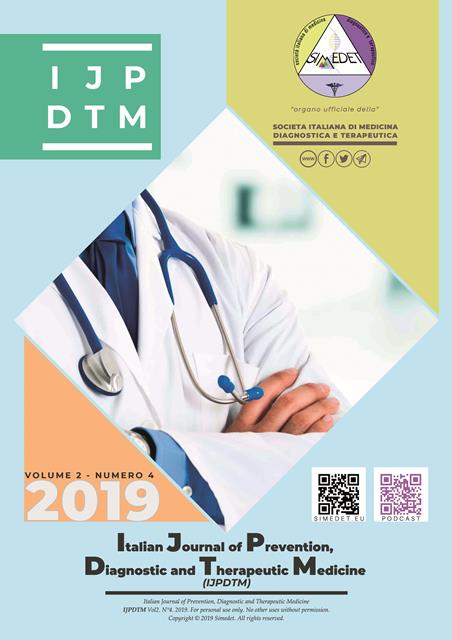Thromboembolic risk in medical patient an extensive review and future perspectives
Main Article Content
Abstract
Introduction: Several patients affected by acute medical illnesses such as congestive heart failure, respiratory diseases, infective or inflammatory diseases, show a concrete, potential, venous thromboembolic risk.
Methods: Many studies have proven relevant reduction of fatal pulmonary embolism due to improved medical practice aimed to provide proper thromboembolic prophylactic therapy.
Results: Despite scientific efforts in clinical prevention, influence of some patients demographic variables are often underestimated (i.e. older age..) and real burden of absolute venous thromboembolic risk and thromboprophylactic efficacy remains unclear. Moreover, establishment and development of Emergency and Acute Care Departments select a patients population that shows more complex features and comorbidities when compared to classical Medicine wards patients, thus making harder the exact choice regarding when and how to administer thromboembolic prophylactic therapy.
Conclusion: The simultaneous assessment of the thrombotic and haemorrhagic risk is the key for an adequate safe prophylaxis, a higher appropriateness of antithrombotic prophylaxis. Thus it is routinely recommended to use proper tools of VTE risk evaluation in order to set the best risk/benefit therapeutic strategy in medically ill patients.
Downloads
Article Details

This work is licensed under a Creative Commons Attribution-NonCommercial-NoDerivatives 4.0 International License.
References
Haas SK (2002) Venous thromboembolic risk and its prevention in hospitalized medical patients. Semin Thromb. Hemost 28:577-584.
Geerts W SR. Prevention of Venous Thromboembolism in the ICU. Chest. 2003;124:357S-63S.
Cullen DJ, Nemeskal AR. The autopsy incidence of acute pulmonary embolism in critically ill surgical patients.Intensive Care Medicine.1986;12:299-303
Pengo V, Lensing AW, Prins MH et Al. Incidence of chronic thromboembolic pulmonary hypertension after pulmonary embolism.N Engl J Med. 2004;350(22):2257-64.
Geerts WH, Pineo GF, Heit JA et al. Prevention of venous thromboembolism: the seventh ACCP conference on antithrombotic and thrombolytic therapy. Chest 2004;126(suppl 3):338-400S.
Samama MM, Cohen AT, Darmon JY, et al.(1999) A comparison of enoxaparin with placebo for the prevention of venous thromboembolism in acutely ill medical patients: prophylaxis in Medical Patients with Enoxaparin Study Group. N Engl J Med.1999;341:793–800.
White RH ( 2003 ) The epidemiology of venous thromboembolism. Circ 17;107(23 Suppl 1):I4-8.
.
Anderson FA Jr, Decousus H, Bergmann JF,et al. A multinational observational cohort study in hospitalized medical patients of practices in prevention of venous thromboembolism and clinical outcomes: findings of the international medical prevention registry on venous thromboembolism (IMPROVE). ISTH Congress; J Thromb Haemostasis 2003;1(Suppl 1): P1438.
Oudega, R., Moons, K. G., Karel Nieuwenhuis,et al. Deep vein thrombosis in primary care: possible malignancy?The British journal of general practice : the journal of the Royal College of General Practitioners, 2006;56(530):693-6.
Tapson VF, Decousus H, Pini M, et al.Venous thromboembolism prophylaxis in acutely ill hospitalized medical patients: findings from the International Medical Prevention Registry on Venous Thromboembolism.Chest. 2007;132(3):936-45.
Cohen AT, Tapson VF, Bergmann JF, et al. Venous thromboembolism risk and prophylaxis in the acute hospital care setting (ENDORSE study): a multinational cross-sectional study.Lancet. 2008;371(9610):387-94.
Chopard P, Spirk D, Bounameaux H. Identifyng acutely ill medical patients requiring thromboprophylaxis. I Throm Haemost 2006;4:915-6.
Cohen AT, Zaw HM, Alikhan R. Benefits of deep-vein thrombosis prophylaxis in the nonsurgical patient: The MEDENOX trial. Semin Hematol. 2001;38(2 Suppl 5):31-8.
Cohen AT, Davidson BL, Gallus AS, et al. Efficacy and safety of fondaparinux for the prevention of venous thromboembolism in older acute medical patients: randomised placebo controlled trial. BMJ. 2006;332:325–9.
Kearon C., Akl E.A., Ornelas J. et al. Antithrombotic therapy for VTE disease: CHEST guideline and expert panel report 2.Chest.2016; 149(2) :315-52.
Spyropoulos AC, Raskob GE New paradigms in venous thromboprophylaxis of medically ill patients. Thromb Haemost.2017; 117:1662.
Nendaz M, Spirk D, Kucher N, et al. Multicentre validation of the Geneva Risk Score for hospitalised medical patients at risk of venous thromboembolism. Explicit ASsessment of Thromboembolic RIsk and Prophylaxis for Medical PATients in SwitzErland (ESTIMATE).Thromb Haemost 2014; 111: 531–8.
Cohen AT, Harrington RA, Goldhaber SZ, et al. Extended thromboprophylaxis with betrixaban in acutely ill medical patients. N Engl J Med. 2016;375(6):534–44.
Vincentelli, GM; Monti M, Pirro M.R.. et Al. Perception of the thromboembolism risk: the differences between the departments of internal and emergency medicine. Keio J Med. 2016;65(2):39-43.
Vincentelli GM, Timpone S, Murdolo G,et al. A new risk assessment model for the stratification of the thromboembolism risk in medical patients: the TEVERE score. Minerva Med. 2018;109(6):436-42.

